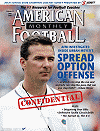AMERICAN FOOTBALL MONTHLY THE #1 RESOURCE FOR FOOTBALL COACHES
Article CategoriesAFM Magazine
|
Do Penalties Help or hurt? You be the Judgeby: AFM Editorial Staff© More from this issue The NCAA officially recognizes 24 different statistics for college football. Everything from Rushing Offense to Passes Had Intercepted is updated on a weekly and seasonal basis. Most recently, an additional statistic is Fewest Yards Penalized Per Game. The top five leaders last fall in this category among Division I-A schools were Vanderbilt, Michigan, Navy, Penn State and Iowa. The combined record of the colleges: 38-21. The most penalized teams included Texas Tech, Colorado, Arizona State, TCU, and Oregon State. Their combined mark: 39-21. Do the amount of penalties your team commits imply defeat? Or, is there a gray area? Among I-AA colleges, the least penalized teams in 2005 included William and Mary, Butler, Davidson, Colum....The full article can only be seen by subscribers. Subscribe today!
|
|
|||||||
| HOME |
MAGAZINE |
SUBSCRIBE | ONLINE COLUMNISTS | COACHING VIDEOS |
Copyright 2026, AmericanFootballMonthly.com
All Rights Reserved





